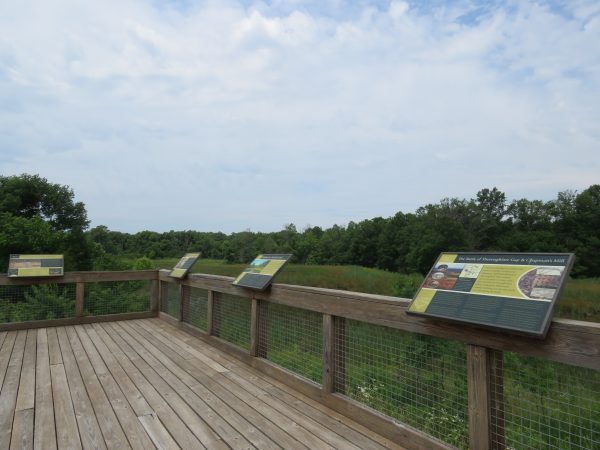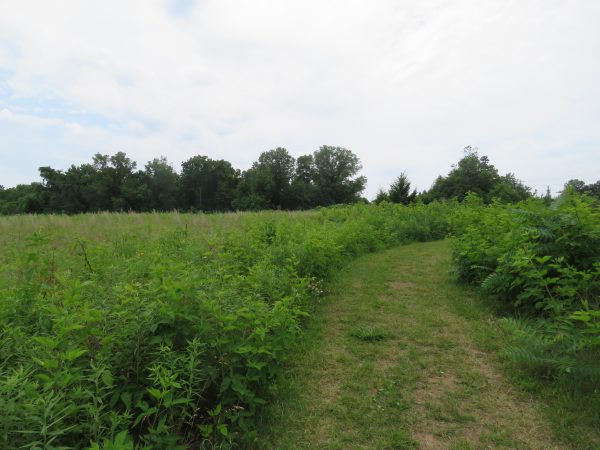Description
Named after the revered naturalist and author, Aldo Leopold, Leopold’s Preserve is a 380-acre nature preserve and urban oasis containing diverse habitats and a rich history. Its 7 miles of natural surface trails traverse wetlands, wildflower meadows, and hardwood forests, providing opportunities to spot a wide variety of birds and other wildlife, including turtles, frogs, deer, muskrat, beaver, butterflies, and dragonflies. Interpretive signs describing the preserve’s natural and historical features can be found throughout its trails. Formerly a farmland, the property continues to be actively restored to native habitats by the White House Farm Foundation and is permanently protected through a conservation easement held by the Northern Virginia Conservation Trust.
A popular location for local birders, over 180 bird species have been documented at Leopold’s Preserve. Wood duck, eastern bluebird, red-shouldered hawk, and red-winged blackbird can be found year-round. From spring through summer, look for green heron, great egret, yellow-billed cuckoo, eastern kingbird, orchard oriole, prairie warbler, and indigo bunting. Lucky visitors may also spot migrating warblers in spring and fall, a diversity of waterfowl in the winter, and the occasional trumpeter swan, American woodcock, Wilson’s snipe, or American bittern in spring.

Observation platform over the wetland at Leopold’s Preserve. Photo by Jessica Ruthenberg/ DWR.
The 0.65-mile Wood Duck Way loop trail is particularly recommended for birders, as it provides views of the preserve’s extensive wetlands and features a large observation platform as well as nest boxes for eastern bluebird and wood duck. A paved path from the parking area provides easy access to the platform. Birders will also enjoy the .25-mile Meadow Loop trail, which travels through a brushy restored meadow, full of native wildflowers and sumacs attractive to birds and pollinators. This trail also leads to a pond with a small island and active beaver dam, making for another good location to spot birds and listen for frog calls. About 0.5 miles east of the pond, on the main Leopold’s Loop trail, is another habitat highlight for wildlife viewers–an upland depression swamp. This ephemeral wetland, attractive to birds and amphibians, is best viewed in the spring or after summer rains.

The pond at Leopold’s Preserve. Photo by Jessica Ruthenberg/DWR
For tree enthusiasts, the preserve offers a self-guided native tree ID walk scattered throughout its trails that contain QR codes with information on the trees.
The public is welcome to join the preserve on their monthly guided nature walks that cover varying themes, which are provided in partnership with Bull Run Mountains Conservancy. Find a schedule on the preserve’s website.

Meadow Loop Trail at Leoopold’s Preserve. Photo by Jessica Ruthenberg/ DWR
Historical Notes:
- This land has served a number of purposes throughout history. It was originally trod by American Indians as early as 10,500 years ago. Archeological evidence recovered on the property suggests that American Indians utilized the property up until 2,500 years ago.
- In 1724, Robert “King” Carter, a wealthy and prominent Virginian, obtained tens of thousands of acres across Virginia. What is now the Preserve was part of Carter’s 12,000-acre Broad Run Tract.
- In 1823 Carter’s great grandson, John Hill Carter, established Falkland Farm on this tract. The vast majority of Leopold’s Preserve lies within the former Falkland Farm. John Hill Carter, like his forefathers, profited from the ownership of enslaved people who grew wheat and raised sheep for wool.
- The Preserve is surrounded by a network of roads that served as “Avenues of Approach” during several significant Civil War battles that were fought within Prince William County. The lives lost during the Civil War are commemorated through the Preserve’s Living Legacy Landscape along Route 15.
- In 1828, the nearby Village of Thoroughfare was established, which was populated largely by freed African Americans who worked at Chapman’s Mill who settled in the area and formed new communities, including a school that stood just inside the northwest corner of today’s Leopold’s Preserve. The Thoroughfare Colored/ North Fork School was opened in 1885 and was one of the first public schools for Prince William County’s African American children. The school operated until 1936.
- By 1900, most of the interior of the Preserve was being cultivated for corn, oats, wheat and hay, and some land owners operated dairy or poultry farms.
Directions
Physical Address: 16290 Thoroughfare Rd, Broad Run, VA 20137
From Haymarket, travel west on John Marshall Highway/Rt. 55, then turn left onto Thoroughfare Road/SR 682. Continue a short distance as the paved road turns to gravel. Cross the railroad tracks and in just a few hundred yards you will see the parking areas located to the left (Parking Lot East) and right (Parking Lot West).
Note: Entrances to the Preserve located within the private Villages of Piedmont community are not for public access.
Location & Directions
View on Google MapsSite Information
- Site Contact: White House Farm Foundation: 571-358-2098, info@whfarmfoundation.org
- Website
- Access: Free, Open daily from dawn to dusk
Birds Recently Seen at Leopold’s Preserve (as reported to eBird)
- Wood Duck
- Mourning Dove
- Ruby-throated Hummingbird
- Lesser Yellowlegs
- Green Heron
- Great Egret
- Great Blue Heron
- Black Vulture
- Red-bellied Woodpecker
- Eastern Phoebe
Seasonal Bird Observations
Facilities
- Accessible
- Hiking Trails
- Information
- Interpretive Nature Program
- Interpretive Trail
- Parking
- Restrooms
- Observation Platform
- Historical Site

